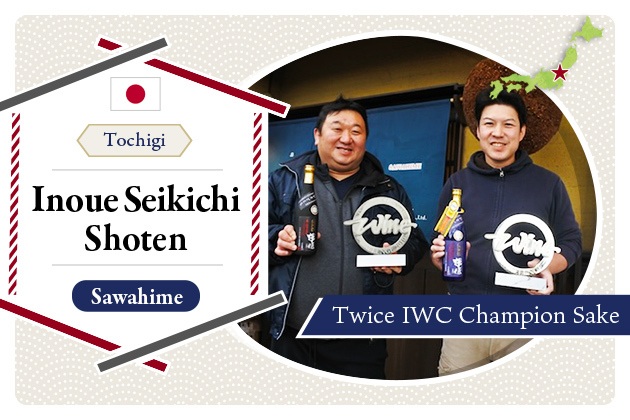
2024.07
24
Five Things to Try When the Sake You Buy Doesn't Taste Good
There may be times when you buy a bottle of sake at a store based on the label or product description, but when you get home and try it, you may find that the taste is not so good. It would be better if you could taste the sake before purchasing it, but by online shopping or at stores that do not allow tasting, you may have to rely on your intuition.
However, the taste of sake varies greatly depending on how you drink it. If you know how to enjoy sake in a wide variety of ways, you will be able to enjoy it more and more, which will make buying and drinking sake even more exciting. In this issue, we will introduce five things you should try when the sake you buy does not suit your taste. If you find something among these that you can try or that is similar to the characteristics of the sake you drank, by all means, give it a try!
Decanting
The easiest way is to decant the sake. Decanting is a technique used when drinking wine, in which the liquid is exposed to air by transferring it from the bottle to a container called a "decanter" to mellow the flavor and open up the aroma.
Even in the case of sake, decanting can change the taste and aroma of sake that you feel is too aggressive into a mellower, more subdued flavor. For example, if you find a bitter taste in fresh sake, or if you find the taste of nama yamahai sake too stimulating, or if you find the aroma of daiginjo sake too strong, you can try decanting the sake.
If you have a decanter like the one used for wine, you can use it, or you can use a teacup to pour sake several times to get the same effect. Once you try it, you will be surprised at how much the taste can be changed by doing just this.
Mixing
Sake is often drunk neat, but if it is a strong-flavored sake, it can also be enjoyed on the rocks or with soda, or simply by adding a little something else to a sake you don't like. Here are some suggestions for mixing sake.
Add tonic water to sake that has hineka
This method is effective with any type of sake, but it is particularly successful with sake that has developed a hineka (old sake flavor) or sickly-sweet nama with robust flavor.
The tonic water’s fizz, refreshing aroma, sweetness and acidity, bring back the flavor of the sake. It is best to adjust the amount of sake and tonic water while observing the balance of flavors.
Adding dashi to bland sake
Add well-warmed dashi to sake to create a rich and relaxing flavor by mixing the sake and dashi. The ratio of sake to dashi is about 1:1.5 to 2.
Dashi can be made by boiling dashi stock, oden, or soba/udon soup. For sake, it is better to try a classic sake than a fruity one.
Other styles that have become popular in Japan include the adding of a coffee ice cube to sake. You can also pursue this further and make sake cocktails.
Warming
The classic method is to warm up sake. In fact, there are some sake that are not suitable for drinking cold, but few that are not suitable for warming up. In particular, if you find that the sake you bought tastes too strong, or if you want a more pronounced flavor, try warming it up. Here are some tips on how to warm up sake in each of these patterns.
Namazake with a strong flavor
Sake, such as a robust-flavored nama genshu, should be warmed up to about 55-65 degrees Celsius (131-149°F). Although you might be hesitant to warm nama, this is often the style practiced at popular specialty sake bars in Japan. Even for pasteurized sake, if it is a low-polished sake (70-90%), or if it has a robust flavor from the Yamahai process, you can raise the temperature as high as that.
Once it is thoroughly warmed, lower the temperature about 6 to 10 degrees from there. If you warm it using a metal chirori, you can quickly lower the temperature by cooling the outside under running water. If you use a microwave, or if you warm it in a ceramic bowl, you can combine it with the "decanting" method introduced earlier to lower the temperature while still allowing it to come into contact with air.
Pasteurized and diluted sake with light flavor
If you want more umami or sweetness from a bottle of pasteurized sake with an alcohol content of around 15 degrees Celsius (59°F), try lukewarm heating to around 40 degrees Celsius (104°F).This will bring out the character hidden deep within the sake and give it a richer flavor.
The trick is to taste the sake before and during warming several times. The sake brought out by raising the temperature will gradually reveal itself as the temperature rises. For example, when you taste the sake as you increase the temperature from 30°C to 35°C to 40°C, if the taste growth from 30°C to 35°C is about the same as that from 35°C to 40°C, you may want to try warming the sake a little more. On the other hand, if there is not much change from 35°C to 40°C, or if you feel that you liked the taste better at 35°C, you should stop warming it at that temperature.
There are many more techniques for warming sake that cannot be discussed in a single article. For this article, please remember two things: (1) warm rich sake hot and then cool it down (2) warm sake that needs a little more flavor to lukewarm. As you use this method as a basis for checking the compatibility of different sake and temperatures, you will come to love hot sake and sake itself even more and more.
Pairing with food
In recent years, various sake breweries have been making sake with unique characteristics by devising new production methods and ingredients. Sake with a unique flavor can be enjoyed if it is well matched to one's taste, but there may be cases where it is not to your liking. In such cases, however, they can be enjoyed with food. Here are two examples of such cases.
Sake with unique acidity and aroma matches Thai or Mexican
Lately, more and more sake breweries have been using traditional methods such as yamahai, kimoto and mizu-moto sake brewing and non-additive yeast brewing to produce sake with a brewery's character. These sake, which are characterized by their acidity and aroma, can be enjoyed thanks to the ingenuity of each brewery, but if you still feel that it tastes unpleasant, try pairing it with Thai, Mexican or Chinese food.
The sour, sweet, and aromatic sake with a tropical feel often goes well with Thai, Vietnamese, or even Mexican food.
In addition to its acidity, sake with a robust flavor and a sense of maturity will go well with Chinese cuisine and Korean dishes such as barbeque. The mild flavor of unique sake goes well with authentic Chinese cuisine, as well as dishes such as Korean BBQ that make the most of the flavors of the ingredients.
Too sweet sake matches salty and oily food
If the sake tastes too sweet, you can try pairing it with sweets, but it can also be paired with a meal: try salty and oily snacks. Cured ham with a little olive oil, for example, goes well with sweet sake.
Sake with a strong flavor, such as aged sake and kijoshu, is delicious with Chinese dishes such as stewed pork or sweet and sour pork.
The world of pairings is wide, and these two are just a few examples. Recently, there has been an increase in the number of pairing experts in Japan who match sake with unique flavors and food to create a synergy of deliciousness.
Aging
The last method I will show you is… Just leave It! It is the easiest and most effective method. The taste of sake, especially when it is unpasteurized, changes on a daily basis. Some people may think that "freshly opened sake tastes best," or may have even received such an explanation. That is not wrong, but this process of change is actually more complicated.
There are times when the taste (the degree of match to your taste) improves over time and other times when it goes down. Since everyone likes the taste at a different point in time, if you leave it for a while, it may taste perfect for your taste after a few days or even a few months. If you repeatedly experiment with leaving sake, you will be able to imagine that when the certain sake is ready to drink.
This method is effective for sake with a wide range of flavors but be aware that for aromatic and delicately balanced sake such as daiginjo, the balance may be lost if not stored at very cold temperatures. Also, pasteurized sake with a light, watery flavor may not change much over time. It is best to drink such sake as they are or in the other ways described so far.
Summary
If you cannot drink sake by any means, you can make it into cooking sake or put it in a bath, but we have introduced five methods based solely on the premise that the sake should be delicious.
Thanks to the efforts of brewers, the number of tasty sake is increasing every year. If you buy sake at a liquor store that focuses on sake, you will probably be able to enjoy it without thinking anything through; however, if you encounter a sake you don't like, please remember what is written in this article!
Pickup Articles
2019.01.18
2019.01.25
Trending Articles
Popular Articles
Recent Articles













